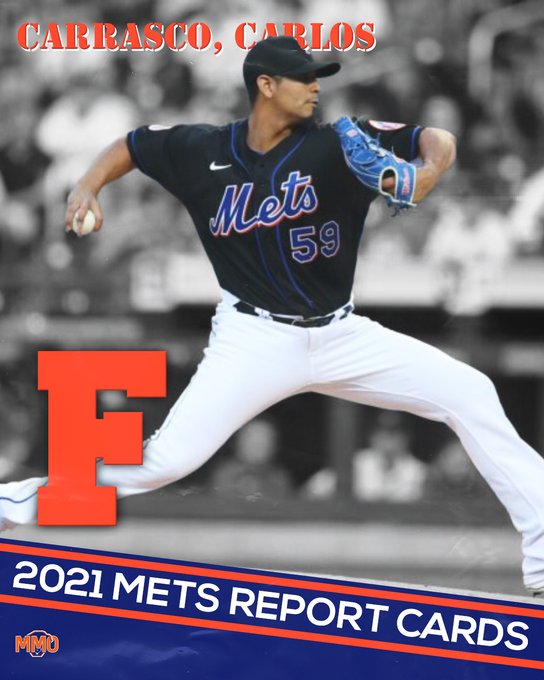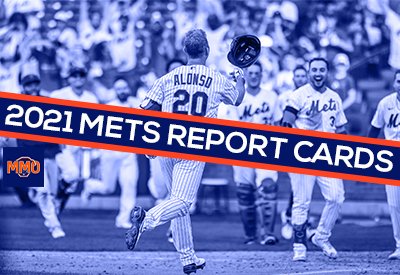
Player Data: Age: 34 (3/21/87), B/T: R/R
Primary Stats: 12 G (12 starts), 53.2 IP, 6.04 ERA, 1.43 WHIP, 1-5, 50 K, 18 BB
Advanced Stats: 67 ERA+, 21.1 KK%, 7.6 BB%, 4.63 xERA, 5.22 FIP, 4.32 xFIP, 0.1 fWAR, -0.8 bWAR
2021 Salary: $12 million
Grade: F
2021 Recap
Well, which injury do we start with?
Soon after first impressions from Carlos Carrasco, who at his introductory press conference brought an optimism and joy on par with his trade-mate Francisco Lindor, the 34-year-old pitcher arrived at spring training with goals to slot behind Jacob deGrom as the team’s middle-of-the-rotation anchor. Soon after that, though, Carrasco went down with a hamstring injury, one that at the time seemed like it’d delay his Mets debut by a couple humid Florida weeks.
But weeks of build up and strengthening came and went, and Carrasco’s hamstring wasn’t ready. (His “I’ll be ready by Opening Day” comments highlight his eternal optimism.) Turns out Carrasco’s hamstring injury was a more severe tear than the public knew, but by mid-June, the Mets and Carrasco had enough confidence they had the hamstring healed enough, and he started throwing off a mound again. By mid-July, Cookie started an official rehab assignment, and a couple weeks later, he’d get the “guy returning from an injury is like a trade deadline acquisition” treatment.

Carrasco’s debut came the same day as the Mets’ black uniforms. He gave up a home run to his first batter.
Though that was the only run he allowed that day (four innings in his first game back), it was indicative of how his first innings went the rest of the way. He allowed eight home runs and 18 runs–all earned–in first innings this season. That put him behind the eight-ball in just about all of his 12 starts.
The story of Carrasco’s season basically comes down to this split:
- First inning ERA: 13.50
- Non-first-inning ERA: 3.89
It clearly took Carrasco 20 or so pitches to settle into his normal routine. But why? The first inning struggles were a bit confusing, as before this season, Carrasco had a career 3.92 ERA over 192 2/3 first innings, and his first inning home run rate over his career hasn’t been different than any other inning.
But then after the season, we found out Carrasco was pitching with loose bone chips in his elbow. It’s been reported that Carrasco knew of the issue all the way back to spring training, but he felt he could pitch through the issue. (He had surgery to fix the issue in early October, and the team says he’ll be ready for spring training.) One theory for Carrasco’s first inning struggles could revolve around the elbow issue. Obviously, pitching with loose bodies in your elbow is something that doesn’t regularly happen. It probably took Carrasco a cycle of in-game pitches to realize what he had working, what he didn’t and what pitches gave him less pain on certain days. Unfortunately in that discovery, Carrasco got hit hard.
He was giving up So. Many. Fly. Balls. in his 12 first innings. Over 46 percent of his batted balls in first innings were fly balls, and eight of those turned into homers. His fly ball rate dropped to 32 percent from the second inning on, and just four of those turned into home runs over 41 2/3 innings. His strikeout percentage jumped, as did his ground ball rate, after the first inning, too. He clearly got more comfortable as the game when on, and that can mean he got more comfortable with his elbow as the game went on.
Nevertheless, the results were the results. They weren’t good. Though the team won five of his 12 starts despite those results, he didn’t put the team in a great position to win on most occasions. Between the setbacks from the hamstring to how he performed once on the field, it was a disastrous season. That doesn’t mean all his lost for his Mets tenure, though.
2022 Outlook
Carrasco will be in the Mets’ rotation in 2022. This is just about certainty. He’s owed $12 million again in 2022, and honestly that’s a decent deal if Carrasco can trend more toward his pre-2021 self than his 2021 output.
This season was an outlier in Carrasco’s career, and the bevy of injuries can pretty clearly explain his struggles. The question is, though, if Carrasco is now a player who gets injured often or if he can remain healthy across a full season. He’ll be 35 in 2022, and that’s not as old for a pitcher as it once was. He can still be effective if he stays on the mound. The Mets don’t need Carrasco to be a top-of-the-rotation guy. They need him to be a reliable fourth or fifth starter, with the assumption Noah Syndergaard will return and that they will be active in the starting pitcher free agent market.
If he’s not a reliable starter or healthy? He has a vesting option for 2023 that triggers with 170 innings pitched in 2022 and a clean bill of health heading into the following season. The ideal scenario will be Carrasco is effective enough to pitch 170 innings next season (for reference: Marcus Stroman hit 179 innings this year making just about every start) and is healthy heading into 2023. That probably means the Mets got a solid year out of Carrasco in 2022.















